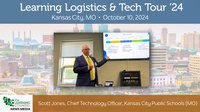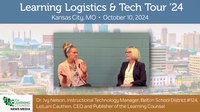The full-scale leap to consumerized learning is at present constrained by forces as thin as gossamer. There isn’t much holding it back as we can see by societal factors. First of all, consider that many families today are dual-income and rely on public education for occupying the time of school-aged kids. This is a positive only when parents are convinced the time is usefully spent. If it is considered irrelevant, which is happening increasingly, then this consideration is potentially at risk. Merely occupying time can be done by other constructs.
Then there is the idea that there have to be accreditations and degrees and “seat-time” for how schools get paid. Since the arrival of MOOCs (Massively Open Online Courses) like Udemy and Khan Academy, the stance of having to be accredited for learning to have occurred is observably a baldly protectionist stance around revenue generation. People can and do learn without a regulator standing over their shoulder. The posturing in this area, while having some merit, associates once inviolate institutions with money-grubbing, and
so quickly puts them under the glaring lights of competitive posturing that have heretofore been reserved for corporations. The public, seeing this sort of behavior, is prone to then look for directly purchasable alternatives and skip the pretensions. Consumer behavior does not always go towards the most costly and prestigious stores – in fact, the majority of it goes in the opposite direction.
Another constraint is the last vestiges of hope from the educational establishment that our 200-year-old system will keep running. Leaders say the general public is not yet ready for a full-scale shift. But change hangs heavy in the air andthe statistics say otherwise.
In a visit by Learning Counsel staff to the Santa Ana Unified School District’s Advanced Learning Academy, Deputy Superintendent of Educational Services Dr. David Haglund mentioned that students presently don’t typically comprehend that they can find and consume learning on their own. They may know games and social media, but consumer-based learning online as an acceptable replacement of the institution is a new idea for many.
Schools like the Advanced Learning Academy have already seen that a heightened personal responsibility in the individual student to take ownership in their own learning has caused a chain reaction in parent involvement. Students make reports and recordings weekly that parents can check and that students are enormously proud to show. Parent responsibility is highly questionable in our present age and could be another factor holding back change.
A shift in parent involvement could be the change agent that fractures the current public education system, as parents pull their kids out to “unschool” or homeschool. Parent cooperatives like Crestmont School are already emerging but are not necessarily taking full advantage of digital learning. However, with social media and some public policy shift to administer a network model, these constraints could easily be overcome. In fact, they are being overcome in some corners already.
Admittedly, the digital consumer user interface and user experience has a way to go. This is another constraint to change. A home-schooler working online can be distracted by pop-ups, advertising, too-small text, “flashing” peripheral animations, ineffective graphics, being branched to the wrong information or exercise, or getting confused as to where they are in the progress through their information or exercises. At times, poor activity navigation or the activities themselves are too bothersome to complete. Needed information may be obscured or too hard to find, screen width or vertical scrolling make comparisons or references too difficult to use, interactions are slowed, or the student may receive crushing negative feedback. Any of these things inject uncertainty, mistakes, and frustrations that may well have been duplicated in the analog world, but can be magnifiedin the digital world.
More particular constraints include the compulsory nature of the educational system, usually directly associated with physical presence and the “butts-in-seats” clauses of old that will require actual legal change. In the meantime, frustration will mount as learners find exception to being marginalized in an old model, disconnected from the allure of interactive personalized design and exhilarating immediacy of the Internet.
Another constraint, though not easily discernable, is how industry has positioned itself to infiltrate the education system but not necessarily alter the distribution of education. Everyone in the game still considers trained teachers to be the required delivery mechanism. Industry is visibly not “all in” with a direct-to-consumer model, and perhaps that has more to do with the maturation of the consumer side to appreciate all that digital learning offers. Across all companies being funded, the major investment houses have largely preferred companies who are selling to institutions and individual teachers. The vast majority of ed-tech start-ups are configured to sell to schools, either as a direct sales model to the institution or a freemium model with a low-end configuration for teachers that costs money only when premium features are needed. Industry seems to prefer having education institutions as a marketplace, largely because a direct-to-consumer model is expensive marketing-wise, even if a sell-to-teachers model is about the same cost to market budgets as selling to consumers. There are, after all, 3.3 million teachers – a massive market by any estimation.
Another consumerization constraint is the industry’s inept marketing and lack of structure. With the sheer size of the education market, similar products have grown to take over small portions of dominion with installs in just enough districts to be commercially interesting. Competitive products take the other geographies or niches, and so the whole of the marketplace looks fractured into various product preferences. When these products are the campus management systems, the learning management or student information or library sytems as repositories for much of the data and the learning objects, a market-wide inefficiency is created. One school cannot share easily with another. A teacher leaving one school or one district to work at another must learn an entirely new system.
Simply stated, unfortunately, this is not the Apple world where everything works with everything. In education, all the major operating systems collide and there is a mish-mash of old legacy and new industry. This is the goal of big industry’s digital evolution, to bring everything up to co-exist smoothly in one ecosystem – preferably theirs if you are Google, Apple, or Microsoft.
Additionally, there are numerous standards bodies, each with a different view as to what constitutes a necessary standard. Some are academically focused on “what” is learned, the actual idea. Others are focused on the technical files being interoperable between major systems, while still others on the meta-tagging of each of the learning objects. And the fact that there is no commercial-grade code structure to allow direct consumption across multiple publishers other than for books, loose lesson plan objects, and videos evidences a missing consumerization link.
Certain types of tags and differentiations of digital curriculum are also missing, such as one the Learning Counsel identified as “Lesson Time Used” in 2014, now known as “LTU,” which has a minimally agreed-upon definition as an equivalency to one class period or 50 minutes. Another is “Cost Per Unit,” shortened to “CPU,” which needs industry and institutions to come to a consensus as to how to think of units whether they are apps, full immersive-environment courseware, subscription websites with a multiplicity of objects, single lesson plans, etc. A single measurement would allow for all teachers and learners to understand what they are getting, at least by a cost factor.
The New Market
Commercially, with tens of millions of learning objects out there roaming the Internet, a new sort of retail market could emerge on the digital plane, creating new mixes of learning content along with hardware. Colleges and universities themselves could have digital bookstores, but the commercial enablement of this reality has yet to occur. Knowstory was constructed with this vision in mind – a hopeful place to make it all make sense together, feed the systems and orchestrations of school systems, and harbor the stories and records of students’ lifetime learning journeys.
Though the constraints of full consumerization of learning are numerous, they can be overcome. The rewards for individual learners could be enormous. An entire world of knowledge and pathways are presented online and consumable from anywhere, sometimes free and
sometimes paid, or offered within the context of a school which may be public and still free. Most importantly, they are navigable and delivering an awesome experience with rewards of knowledge. For teachers, the future of being a content creator or content “mixologist” promises a lot of individual freedom and even a far greater flexibility and income, which exists right now only minimally in an institutionally dominated construct. For institutions, the opportunity exists for reinvention to be a branded hub of great digital mixology, a finely wrought crafting of courseware with real-world social dynamics. Reaching the consumerization of learning could be the differentiator that turns the critics of present-day education away to seek other industries as prey.
Once through the transition to consumerized learning on its own terms, education will be the bright economic and achievement differentiator long sought for the U.S. and the world.
Reference Material:
Collins, Allan & Richard Halverson, “Rethinking Education in the Age
of Technology: The Digital Revolution in Schooling in America”, 2009,
Teachers College Press, by Teachers College, Columbia University.
F. T. Carlton, “Economic Influences upon educational progress in the
United States”, 1820-1850, Richmond, VA: William Byrd Press, 1965, (originally published in 1908 by the University of Wisconsin).
Learning Counsel, 2015 Digital Curriculum Strategy Survey.











